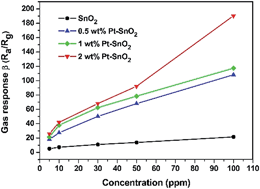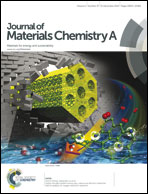Combustion synthesis of porous Pt-functionalized SnO2 sheets for isopropanol gas detection with a significant enhancement in response†
Abstract
Pt-functionalized SnO2 sheets with Pt contents of 0, 0.5, 1, and 2 wt% were synthesized by a facile solution combustion synthesis, and their crystal structure, morphology, and chemistry have been thoroughly characterized. In the combustion process, the urea (CO(NH2)2) has been employed as a fuel. The obtained products appear as porous sheets formed by the interconnected and loosely packed SnO2 nanoparticles. Pt nanoparticles are assembled together with SnO2 nanoparticles in several up to tens of nanometer clusters. The as-synthesized products were used as sensing materials in the sensors to detect the isopropanol (IPA) gas. Gas sensing tests exhibited that the Pt-functionalized SnO2 are highly promising for gas sensor applications, as the operating temperature was lower than current IPA sensors and the response to IPA was significantly enhanced. The 2 wt% Pt–SnO2 sheet based gas sensor displayed a response value of 190.50 for 100 ppm IPA at an optimized operating temperature of 220 °C, whereas the pristine SnO2 based gas sensor only showed a response of 21.53 under the same conditions. The roles of Pt nanoparticles on electronic sensitization of SnO2, catalytic oxidation (spillover effect), and the increased quantities of oxygen species on the surface of SnO2 are plausible reasons to explain the significant enhancement in response to a Pt-functionalized SnO2 sheet based gas sensor.


 Please wait while we load your content...
Please wait while we load your content...